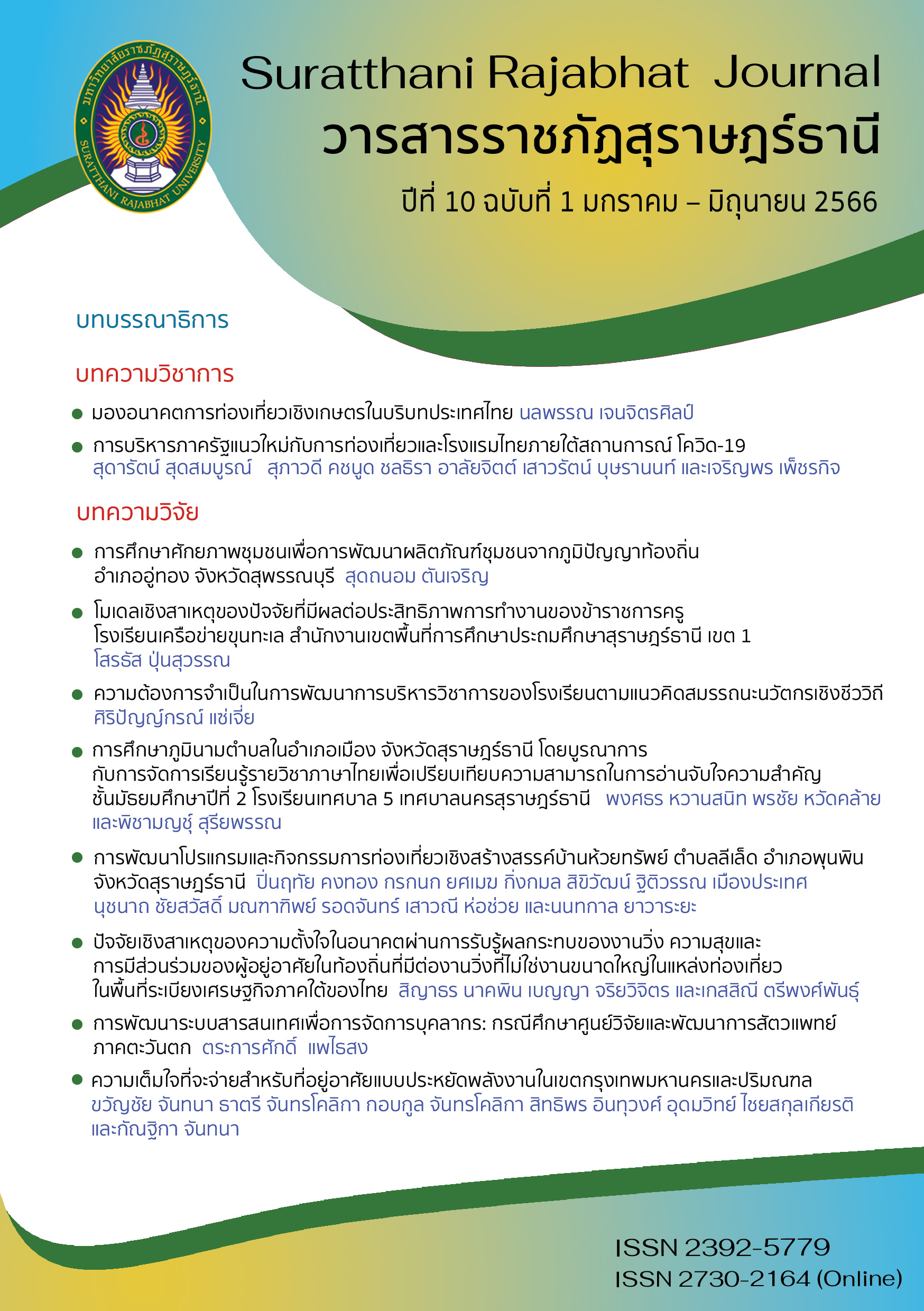The Development of Program and Creative Tourism Activities of Ban Huai Sap, Leelet, Phunphin District, Suratthani Province
Main Article Content
Abstract
This qualitative research aimed to study tourism potential and develop programs and creative tourism activities of Ban Huai Sap, Leelet, Phunphin District, Surat Thani Province. Key informants included community leaders, citizens, tourism center staff and entrepreneurs total 14 people. They were selected by using the purposive sampling methods, an in-depth interview participatory observation and focus group. The results were analyzed by content analysis. The results highlighted tourism potential in five sub-items; 1) Tourist attractions: this included the beautiful nature and natural environment. There are also some man-made attractions such as a bird-watching tower, an area with houses and settlements from ancient domestic culture, as well as the merchandise of many unique domestic products. 2) Hospitality: there are several homestays available. 3) Accessibility: as some parts of the access-road to the community are difficult to pass, the access to this area can be inconvenient but doable for all types of transportation. 4) Facilities: there are restaurants, community shops, souvenir shops, tourist information center, parking space except clean toilets which is not sufficient. 5) Activities: the community offers three types of touristic activities which are nature study, demonstration of knowledge and water activities. According to the development of programs and creative tourism activities, three innovations of creative tourism activities; sea boxing, canoeing, and mud sledding (Ka Dan Teeb), and five creative tourism programs; four programs of one-day trip and another one program of two-day, one night trip were created.
Article Details

This work is licensed under a Creative Commons Attribution-NonCommercial-NoDerivatives 4.0 International License.
References
Bhotisita, C. (2009). The science and art of qualitative research. Institute for Population and Social Research, Mahidol University, Thailand.
Bunyapak, W. (2007). Sustainable management of Thai tourism resources. Sukhothai Thammathirat Open University, Thailand.
Chinachot, P. & Chantuk, T. (2016). Modelof Creative Tourism Management in Suan Phueng. Veridian E-Journal, Silpakorn University, 9(1), 250 – 268.https://he02.tci-thaijo.org/index.php/Veridian-E-Journal/article/view/52759/43803.
Community Based Tourism Institute. (2013). Community-Based Tourism Standards Guide. Wanida Karnpim.
Community Development Department, Ministry of Interior. (2018). OTOP Nawatwithi. https://cep.cdd.go.th/otop-นวัตวิถี/otop-น%25E
Designated Areas for Sustainable Tourism Administration. (2013). Creative Tourism Model Project. http://www3.dasta.or.th/en/.
Dickman, S. (1996). Tourism : An introductory text (2nd ed.). Hodder Education.
Gaffar, V., Wetprasit, P. H. P., & Setiyorini, D. (2011). Comparative study of tourist characteristics on cultural heritage tourism sites: survey of tourist in Indonesia and Thailand heritage sites. Journal of Tourism, Hospitality & Culinary Arts, 3(3), 53 - 68. https://ir.uitm.edu.my/id/eprint/44428/1/44428.pdf.
I-sichaikul, R. (2003). Introduction to tourism and tourism industry.Sukhothai Thammathirat Open University, Thailand, 409 – 437.
Khongthong, P. & Namwong, S. (2016). Factors Affecting the Success of Cultural Tourism Destination Development of Nakhon Si Thammarat Province Journal of Intemationd and Thai Tourism, 12(2), 1-32. https://so02.tcithaijo.org/index.php/jitt/article/view/103582/82806.
Khongthong, P., Yenchaiyapruek, R. & Meesawatdikul, W. (2019). The Potential of Cultural Tourism of Wat Phra MahathatWoramahawihan, Nakhon Si Thammarat : The Foreign Tourists’ Perspective. Suratthani Rajabhat Journal, 5(2), 249-272. https://so05.tci-thaijo.org/index.php/srj/article/view/149618/109806.
Lacher, R. G., Oh, C. O., Jodice, L. W., & Norman, W. C. (2013). The role of heritage and cultural elements in coastal tourism destination preferences a choice modeling–based analysis. Journal of Travel Research, 52(4), 534 - 546. https://journals.sagepub.com/doi/10.1177/0047287512475215.
Lee Led Subdistrict Administrative Organization. (2017). Ban Huay Sap. http://www.leeled.go.th/general1.php.
Likitsarun, N. (2019). The Potentials of Tourism Attraction in Phichit Province. Journal of Thai Hospitality & Tourism, 14(1), 28-41. https://so04.tci-thaijo.org/index.php/tourismtaat/article/view/175024/125239.
Noo-urai, N. (2016). A Study of Creative Tourism Potentiality in Area of KhlongPa Payom-Khlong Ta Nae Basin Community, Pattalung Province. Journal of Southern Technology, 12(2), 53-65. https://so04.tci-thaijo.org/index.php/journal_sct/article/view/139313/153981.
Praneetham, C., Charusirichai, N. & Mouepraman, A. (2019). Behavior of Thai Tourists in Selecting Accommodation in Muag District, Surat Thani Province. Journal of Kanchanaburi Rajabhat University, 8(1), 91-106. https://so03.tci-thaijo.org/index.php/KRUjournal/article/view/144924/143887.
Prideaux, B. (2002). Building visitor attractions in peripheral areas—Can uniqueness overcome isolation to produce viability?. International Journal of Tourism Research, 4(5), 379-389. https://doi.org/10.1002/jtr.387.
Richards, G. (2011). Creativity and tourism: The state of the art. Annals of Tourism Research, 38(4), 1225–1253.https://www.researchgate.net/publication/241854896_Creativity_and_Tourism_The_State_of_the_Art.
Richards, G. (2015). Recipes for sustainable creative tourism. In Proceedings of the Third Business Management International Conference, Pattaya, Thailand, 5–6 November 2015.
Richard, G., & Wilson, J. (2006). Developing creativity in tourist experience: A solution to the serial reproduction of culture. Tourism management, 27(6), 1209-1223. https://www.sciencedirect.com/science/article/abs/pii/S0261517705000749.
Sheng, J., & Lo, A. (2010). Evaluate the tourism potential of public museums in Hangzhou: A supply-side perspective. Journal of Travel & Tourism Marketing, 27(3), 287 - 305. https://doi.org/10.1080/10548401003744719.
Somkeatkun, W., Ruengdet, K. & Boonkong, B. (2019). The Creating Approach of an Application for Creative Tourism Route in Chaiya district, Suratthani province The journal of social communication innovation ,7(1), 144-155. https://so06.tci-thaijo.org/index.php/jcosci/article/view/199958/139755.
Srithong, C & Wongmontha, S. (2017). A Study of tourism Potential in Kanchanaburi Province as a Special Economic Zone.Rajapark Journal, 11(24),115-134. https://so05.tci-thaijo.org/index.php/RJPJ/article/view/120624/92067.
Srijongsang, S. (2018). Creative Tourism Activities Development in Bakchum Communiy, Nonkor Subdistrict, Sirinthorn District, Ubon Ratchathani Province. Journal of Liberal Art, Ubon Ratchathani University, 14(2), 189-208.https://so03.tci-thaijo.org/index.php/jla_ubu/article/view/242340/164379.
UNESCO. (2006). Towards sustainable strategies for creative tourism: discussion report of the planning meeting for the 2008. International Conference on Creative Tourism; UNESCO: Santa Fe, NM, USA, 2006.
Wisutthiluck, S. (2015). Knowledge of Creative Tourism: A Guide and Guidelines. https://socanth.tu.ac.th/outreach/publication/suddan-2558/.


